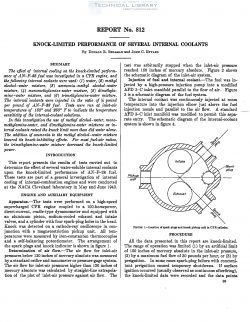naca-report-812

- Version
- 177 Downloads
- 930.79 KB File Size
- 1 File Count
- August 31, 2016 Create Date
- August 31, 2016 Last Updated
National Advisory Committee for Aeronautics, Report - Knock Limited Performance of Several Internal Coolants

Preignition-limited performance data were obtained on a
supercharged CFR engine at two sets of operating conditions
over a wide range of fuel-air ratios to determine the preignition
characteristics for the following fire fuels: 8—3 reference fuel,
S—S plus 4 ml TEL per gallon, AFB—33 (MO—P), benzene, and
d-iisobutylene. liarimum thermal—plug temperatures at con-
stant intake—air pressures were also determined to correlate the
preignit-ion characteristics of each fuel smith its ability to increase
general engine-temperature lerels. Additional runs were made
to compare the preignition-limited performance of triptane,
triptane plus 4 ml TEL per gallon, and :1N—F—28R fuel.
The results indicated that in thefuel-air—ratio range from 0.070
to 0.085, the relative order of the fuels according to increasing
preignition-limited indicated mean efectire pressures was
diisobutylene, benzene, 18—8, AFB—38, and 8—3 plus 4 ml TEL
per gallon. The relatire order of the fuels for the two sets of
operating conditions was not the same for all fuel-air ratios.
The addition of tetraethyl lead to either S—3 reference fuel or
triptane raised the preignition—limited performance. The plot
of fuel flow against airflow at the preignition limit for each fuel
shows that the data approximately follow two straight lines: one
for the rich-mixture region and one for the lean-mixture region.
The respective slopes of these lines changed only slightly in the
various preignition-limited runs.
Preignition and knock are two distinct types of fuel failure;
the occurrence of either preignition or knock may lead to
excessive engine temperatures or stresses with concurrent
destruction of engine components. Each may also alter
engine combustion and engine temperature in such a way as
to increase the probability that the other may occur.
Extensive investigations have been completed and are
still being conducted to determine the knock—limited per-
formance of aviation-fuel components.
| File | Action |
|---|---|
| naca-report-812 Knock Limited Performance of Several Internal Coolants.pdf | Download |

Comment On This Post